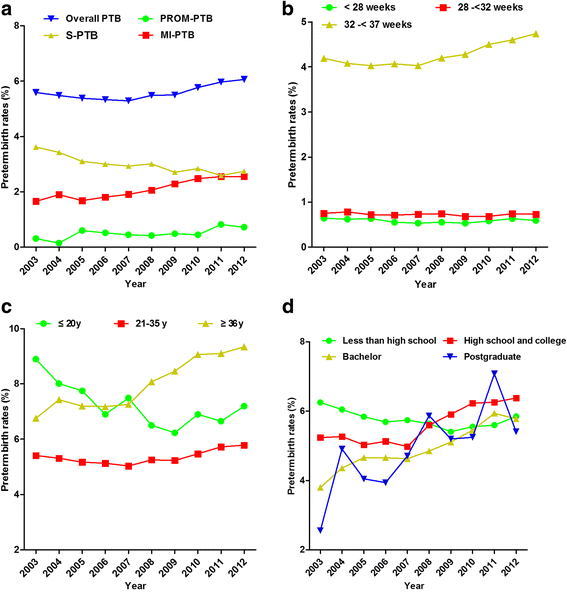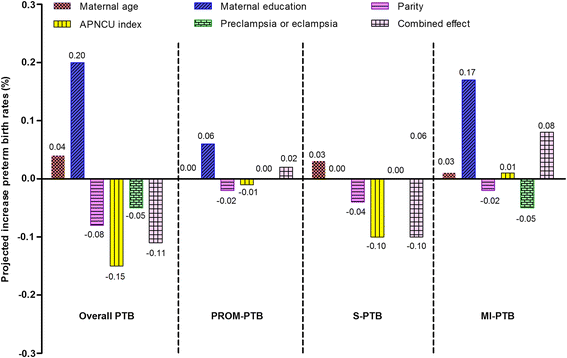Temporal trends of preterm birth in Shenzhen, China: a retrospective study
- PMID: 29534760
- PMCID: PMC5851155
- DOI: 10.1186/s12978-018-0477-8
Temporal trends of preterm birth in Shenzhen, China: a retrospective study
Abstract
Background: Preterm birth is the leading cause of child mortality under 5 years of age. Temporal trends in preterm birth rates are highly heterogeneous among countries and little information exists for China. To address this data gap, we investigated annual changes in preterm birth incidence rate and explored potential determinants of these changes in Shenzhen, China.
Methods: A total of 1.4 million live births, during 2003-2012, were included from the Shenzhen birth registry. Negative-binominal regression models were used to estimate the annual percent changes in incidence. To identify the potential determinants behind temporal trends, we estimated the contribution of each changing risk factor to changes in rate by calculating the difference in population-attributable risk fraction.
Results: Annual preterm birth incidence rates increased by 0.94% (95% CI 0.30%, 1.58%) overall, 3.60% (95% CI 2.73%, 4.48%) for medically induced, and 3.13% (95% CI 1.01%, 5.31%) for preterm premature rupture of membranes, but decreased by 2.34% (95% CI 1.62%, 3.06%) for spontaneous preterm labor. Higher maternal educational attainment (0.20 rate increase), lower proportion of inadequate prenatal care (0.15 rate reduction), more multipara (0.08 rate reduction), decreased proportion of preeclampsia or eclampsia (0.05 rate reduction), and larger proportion of young and older pregnant women (0.04 rate increase) were significant contributors to the overall change over time. Contributions of changing risk factors were different between preterm birth subtypes.
Conclusions: Preterm birth rate in Shenzhen, China increased overall during 2003-2012, although trends varied across three preterm birth subtypes. The rising rates were associated with changes in maternal education and age.
Keywords: China; Incidence rate; Medically induced preterm birth; Preterm birth; Spontaneous preterm birth; Temporal trend.
Conflict of interest statement
Ethics approval and consent to participate
This study was approved by the medical ethics committee of School of Public Health, Sun Yat-sen University. Data used in the study were anonymous and individual patient consent was not required.
Consent for publication
No applicable.
Competing interests
The authors declare that they have no competing interests.
Publisher’s Note
Springer Nature remains neutral with regard to jurisdictional claims in published maps and institutional affiliations.
Figures


References
-
- Blencowe H, Cousens S, Oestergaard MZ, Chou D, Moller A-B, Narwal R, et al. National, regional, and worldwide estimates of preterm birth rates in the year 2010 with time trends since 1990 for selected countries: a systematic analysis and implications. Lancet. 2012;379:2162–2172. doi: 10.1016/S0140-6736(12)60820-4. - DOI - PubMed
-
- World Health Organization . Born too soon: the global action report on preterm birth. 2012.
MeSH terms
Grants and funding
LinkOut - more resources
Full Text Sources
Other Literature Sources
Miscellaneous

